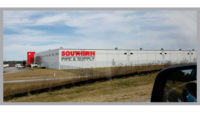From the Editor | Natalie Forster
First Supply to install Exotec robotic system in new 308,000 square-foot distribution center
Robotics in the warehouse.

Exotec’s Skypod System. Photo courtesy of Exotec
The global warehouse robotics market is expected to reach a $12.99 billion value by 2030. Believed to be faster and less prone to error, warehouse robotic systems are commonly used to automate tasks like picking, sorting, transporting and packing.
PHCP-PVF wholesaler-distributors are adopting warehouse automation at various paces. For example, Wisconsin-based First Supply is partnering with Exotec, a $2 billion global warehouse robotics provider, to install Exotec’s Skypod warehouse robotics system to the company’s new 308,000-square-foot distribution center in Western Wisconsin.
“This decision will significantly contribute to reducing lead times and ensuring better inventory management,” says President and CEO Katie Poehling Seymour. “This means customers can expect quicker order fulfillment, improved product availability, and ultimately, a better overall experience.”
Poehling Seymour says the new distribution center has been in the works for quite some time. “This is an idea that we are confident will improve our own business practices and greatly impact the communities that surround us,” she says. “I am excited to see this investment into the Coulee Region support our entire footprint that we were able to expand into thanks to the dedication of those in the community where it all started.”
One common hesitation when it comes to implementing robotics and warehouse automation is the loss of jobs. Poehling Seymour emphasizes the intention of these new systems is to support and improve conditions for First Supply employees.
“Our commitment to our people is unwavering, as they remain at the core of our operations. We strive to enhance their work experience daily, utilizing robots and advanced technology to support and improve our operations without replacing our valued team members,” she says. “Our objective is to empower our employees with the best tools to excel in their roles. This involves working smarter, not just harder, by innovating our operations through technology and refined procedures, while also investing in our workforce.”
First Supply was looking for flexibility, scalability and simplicity when in search for a warehouse robotics company.
“We were introduced to Exotec by SNS, a consulting company, and were immediately impressed by the flexibility and scalability of their technology. During our rigorous review process, Exotec's solution stood out due to its simplicity, which will enhance our speed, accuracy, and inventory management capabilities,” Poehling Seymour says. “Their disciplined approach is key to helping us implement our initiatives efficiently, supporting our growth. As we innovate and prioritize our workforce, we see Exotec as a crucial partner for our success.”
The system First Supply will be implementing is called the Skypod System. Exotec’s Skypod system is the first of its kind to use mobile robots that can move in three dimensions. Laser scanner navigation and advanced automation allow the Skypods to navigate inventory racks and the warehouse floor in a multidirectional manner, carrying up to 66 lb. bins, freeing up time for warehouse workers to focus on packing/shipping, and avoiding long-distance walks/lifting to access inventory.
Stanislas Normand, managing director North America for Exotec, says companies can easily expand throughput and storage by adding robots, modular storage racks and stations, which was a main selling point for First Supply.
“First Supply's Skypod system will consist of over 43,000 storage bins, 36 robots, three picking stations, and three induction workstations. Anticipating continuous growth, First Supply has designed the distribution center to easily scale its storage capacity by up to 30% in the system by adding bins and robots,” he says. “The system will make use of Exotec's smart conveying technology, Skypath, to feed six packing stations and a sortation loop with 12 outbound destination lanes.”
As with any new technology, there are hurdles and hesitations for wholesaler-distributors to overcome before implementing. For example, not all companies need high throughout and effectively operate with basic mobile shelves. Conversely, other wholesalers are best served by traditional shuttle systems that offer high-level performance but tend to be more monolithic and offer little flexibility when it comes to scaling the system post-deployment.
And of course, cost is a huge factor. According to Normand, it’s important to have a long-term, big picture mindset when looking into automation.
“With the pressure to maximize profits in a challenging economic environment, cost is often a key consideration. Some companies considering warehouse automation focus on the price tag of new technologies in the short term and are hesitant to adopt them,” he says. “With this short-term mindset, they miss that these automation tools are a necessary cost-effective investment needed to evolve their logistics operations to meet complex consumer demand and expectations and remain competitive in the long term.”
No matter where your company stands when it comes to the automation conversation, there’s no denying that robots are in our future, both inside and outside of the warehouse. Normand says supply chain data management continues to become more advanced.
“Today the data is increasingly being used to inform and optimize supply chain decisions. As the supply chain becomes more digitized, companies will get better access to real-time data that allows for quicker decision-making. In the long run, I can see more companies investing in tools that provide them with end-to-end visibility throughout their entire supply chain to quickly identify bottlenecks and ensure that goods get delivered to customers in the most effective way possible.”
Looking for a reprint of this article?
From high-res PDFs to custom plaques, order your copy today!







